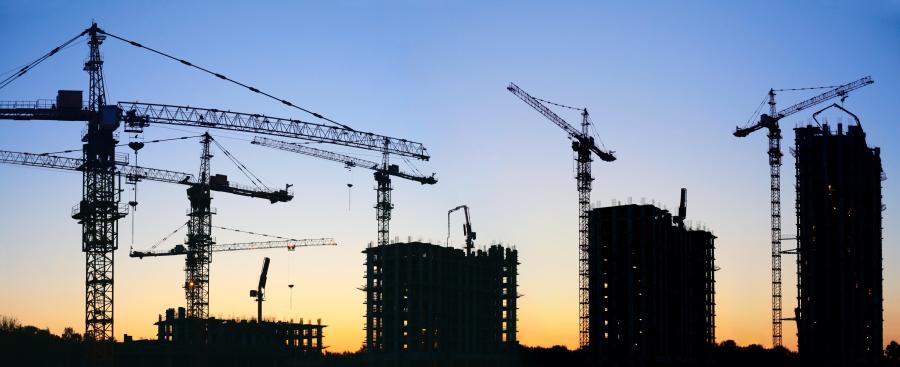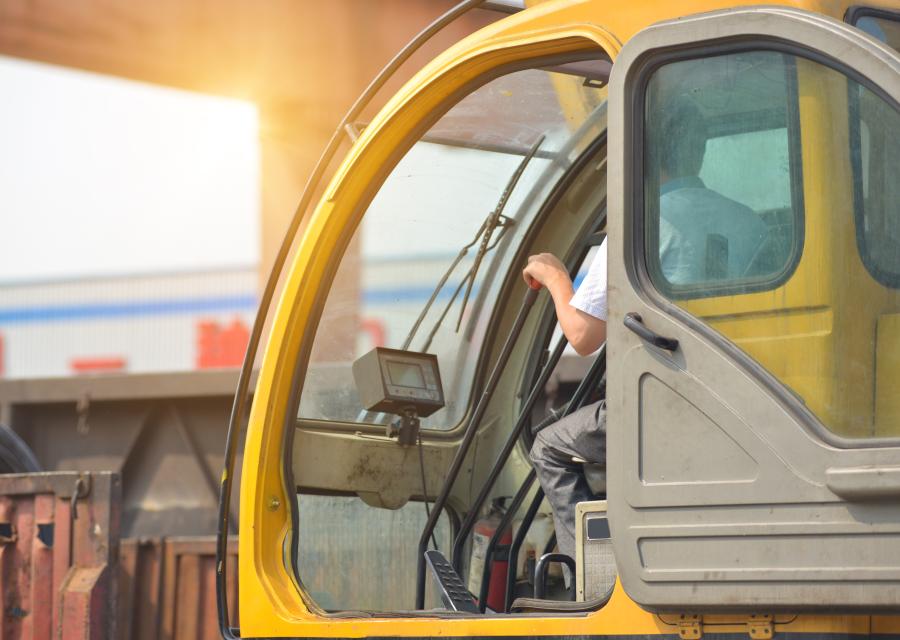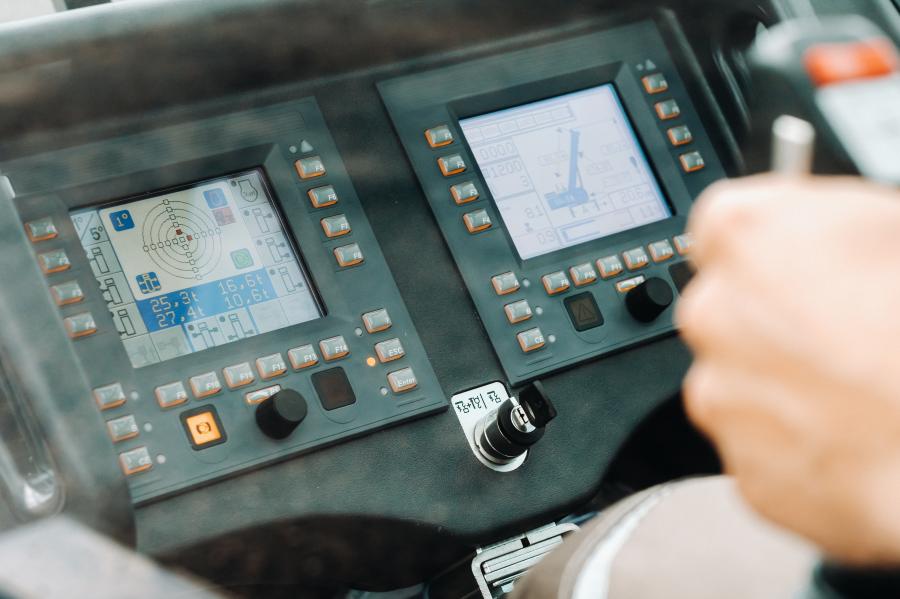
Tue June 6, 2023
Lucy Perry – CEG CORRESPONDENT
Safety and efficiency are at the heart of crane operations on a construction site. Improving and ensuring both are always the goals. Mitigating jobsite hazards is one benefit of a crane camera. Either on the tip of the boom or on the hook block, a camera is an essential safety device on any construction crane.
Because of their sheer size and moving parts, cranes can pose a number of hazards on a job site.
The Crosby Group notes the most common cause of fatalities in construction is being struck by an object that falls from a crane. The Tulsa, Okla., material handling solutions provider said other fatalities include being run over by and falling from a crane.
"When a crane operator is lifting and lowering loads, there are blind spots," according to a Crosby white paper on crane camera technology.
They are unable to see the loads below the hook or boom or actively be able to gauge the surrounding area, said the company.
"A large number of accidents could be avoided with cranes with audio and visual systems installed."
A camera affords the crane operator an unobstructed view of the lift from their crane cab.
It also aids the operator in an awareness of where the load is below the hook at all times, as well as the surrounding area. Many hazardous situations can be prevented or mitigated through the use of a camera on the crane. For instance, an operator may not have a line of sight to the load, grounds crew, other equipment, nearby buildings or overhead power lines.
As Crosby points out, this situation can cause accidents to personnel as well as damage to expensive equipment. This hazard also can bring construction to a halt, incurring heavy costs for the contractor.

Camera technology allows the operator to visually see if a load becomes unstable and notice rigging failures before they happen.
Crosby said the device can help the operator accurately steer loads into tight or awkward spaces. It guarantees the operator receives clear instruction from the crew on the ground, whom they can now avoid.
A camera also can quickly alert the crew of a possible hazard involving the crane. The safety tool helps the operator avoid hitting buildings surrounding the lift site and can prevent damage to a contractor's assets.
Finally, use of crane camera technology has been proven to improve efficiency in the crane operations.
"With a camera system installed to the crane, construction sites will be a safer more efficient environment," said Crosby.
With camera technology, a crane operator is able to see the loads attached below the hook or boom from any crane cab.
As Crosby explains, of its system, the sound and view from below the camera are transmitted and received wirelessly. The transmission takes place from the antenna system to a screen in the cab.
"This allows the operator to see and hear the load and surroundings," said Crosby.
It also gives them an unobstructed, live, audio-visual feed of the critical areas that working in the blind would never allow.
"Any industries utilizing cranes can be affected by crane-related accidents," said the company. "Research and feedback from customers clearly point to the fact that crane camera systems greatly reduce hazards and injuries that bring construction to a halt."
Cameras also can offer a solution during dark or hazy nighttime crane work, said Carmen Zajicek of Crane Warning Systems.
The Atlanta, Ga., crane system provider noted that while most projects are executed during the day, tight deadlines force others to operate at night.
"These are unfavorable working conditions that increase the need for better lighting for workers working during night shifts," said Zajicek. "Cameras are safe, quick and efficient solutions for crane operators working under the dim light of dusk and dawn."
The devices help the operator view all the lifting operations through a bright on-screen display.
History of Jobsite Safety
The first crane cameras were mounted on the jib and were aimed down onto the load. With this technology, real-time video in the cab provided the operator situational awareness.
Camera manufacturer Sensera Systems said, "We are now seeing other use cases and approaches being taken" with these safety tools.
Today's camera versions are often mounted on the hook block to provide a more dynamic view of the load and the lift.
These versions also use sensors to provide productivity statistics to the team, said the Golden, Colo., company.

Another application popular these days is using the crane's height and viewpoint to capture real-time imagery of the complete job site.
"This imagery supports project teams with a variety of use cases in productivity, safety, quality assurance and coordination," noted Sensera.
In this application, cameras can be mounted on the crane tower, or jib provided they are solar/battery powered and wireless.
With wireless technology, no complex wiring is required, said the company, whose devices are suited for this use.
High resolution images and real-time streaming video are provided to the entire project team simultaneously.
"It's important that the system be rugged, lightweight, completely solar/battery powered and reliable," advised the company.
From a moving component of the crane, such as the jib, the camera can capture images from multiple viewpoints. The technology is capable of supporting advanced applications joining reality capture, drawings and models with the job schedule.
Clear Picture
Current lifting practices do not solve the problem of blind spot lifting, said Taiwanese camera manufacturer Scarlet Tech.
"This is the important role [a] wireless crane hook camera can bring to crane operation safety."
Mounted on the hook of the crane, the camera eliminates the hazards associated with lifting in the blind. Now the crane operator has live audio and video footage with the ability to see and hear activity below the hook and around the load.
"Crane hook cameras also prove to increase lifting efficiency," said the company.
That's because the operator can now clearly see the load while communicating with ground staff.
"Communication becomes much easier and less stressful," said Scarlet Tech.
With a hook camera system, safety personnel and project managers can monitor the construction site remotely. The system also allows them to access video data for analysis of the lifting operation, the ground crew and the job site.
"Managers can watch the live videos or recorded footage from [a] tablet or Windows PC."
Location, Location, Location
While the use of a camera on a tower crane can be beneficial, cameras must not replace a qualified signal person, cautioned haulage broker Safe and Insured.
The Great Britain service provider believes that the technology should be used as a communication tool between operator and signaler.
"Cameras can be attached to the tower crane in various positions," according to the company.
A camera mounted on the hook block eliminates the need for a zoom lens to see the load below, said the brokerage.
"It provides a view from above and the camera can be accessed at ground level."
There are disadvantages to this positioning, though. At that spot, the camera is most sensitive to windy conditions. The size of the load may obscure the camera's viewpoint. And, the camera's battery power and wireless operating equipment will need recharging.
Mounted on the trolley of a flat-top or saddle crane, the camera is unlikely to be struck or damaged.
Solar power operates the camera, and the view is not sensitive to hook block rotation or the wind.
Disadvantages, according to Safe and Insured, can include the need for a zoom lens to see loads accurately from taller tower cranes.
Another drawback is the need for a personnel basket for access to the camera when its maintenance is required.
With a jib-mounted camera on a luffing crane, power can be furnished via both solar and hard wire, noted the company. The camera is "unlikely to be struck or damaged and the view will cover the load, hook block, hoist rope and lifting accessories," they said.
As with a trolley, the jib mount may require a zoom lens on taller cranes and will likely require a personnel basket for maintenance
A "jib-mounted [camera] also requires a pivot mechanism to be installed so the view is not obscured when the jib angle is altered," said the broker.

In the crane cab, the camera monitor must not restrict the operator's direct line of sight or impede any of their controls.
One other reminder from the brokerage: The monitor should be able to be seen in direct sunlight.
"Camera systems and their components should be fastened securely to lower the chance of anything falling from the crane," said the broker.
"When a camera is installed using magnets, extra security tethers also should be installed as a backup."
Tethers should be fastened to suitable anchor points. And they should be able to take twice the weight of the item secured. Tethers should be as short as possible to lower the chance of snags or contact with other parts of the crane.
"Any carabiners used should be double action locking and [designed] for outdoor use," said Safe and Insured.
Tower crane cameras should be inspected to confirm the device is working as intended. Confirm that the camera, batteries and associated parts are secure and there is no damage to cables, connectors and security tethers.
"The frequency and responsibilities of the inspections and maintenance vary depending on the positioning of the camera," said the broker. CQ
 Cranes Equipment
Cranes Equipment Articles
Articles Email Updates
Email Updates Sell Your Machines
Sell Your Machines

 Cranes Equipment
Cranes Equipment Cranes Dealers
Cranes Dealers Cranes Articles
Cranes Articles Email Updates
Email Updates Sell Your Machines
Sell Your Machines